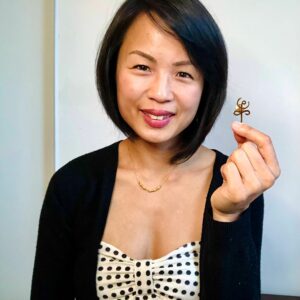What’s the secret to making music fearlessly and joyfully? In our April 24th online workshop, Dr. Lynn Kuo—assistant concertmaster of the National Ballet of Canada Orchestra and founder of Violin with Dr. Lynn —will talk about what it means to be a “Musical Ninja”: how to harness harmony as your secret weapon in order to develop musicality.
We reached Lynn at her family home in St. John’s, Newfoundland and Labrador, where she returned as a professor in early 2020 and where she is currently staying during the pandemic-forced cancellation of the National Ballet of Canada season and of her freelance work in Toronto.
You came to the violin relatively late, didn’t you?
Yes, my first instrument was the piano, which I began playing at age 7. At the time, my family lived in the small town of Stephenville, Newfoundland and Labrador, which had formerly been home to a U.S. Air Force base. I began taking violin lessons later, when I was 9, from a local fiddler. I started formal Suzuki method training when my family moved to St. John’s [the provincial capital]. Most Suzuki students start much younger, at 3 or 4. When I started violin, I could already read music, because I’d had two years of piano training.
I continued both my piano and violin studies until I was 17. I then entered into my bachelor of music degree at Memorial University of Newfoundland. All first-year music students were required to participate in choir, and I fulfilled the requirement by accompanying the choir on the piano, even though I was a violin major!
You’ve been in the National Ballet of Canada Orchestra for more than 20 years. How did you get the job? Were you especially interested in ballet?
I went in completely inexperienced! I had never even seen a ballet when I auditioned for the orchestra. I was still in school, in the second year of my master’s degree at the University of Toronto. I was aiming to win a section violin position in the orchestra, and I used the assistant concertmaster audition the week before as a dress rehearsal for the section violin audition. For my own selection piece, I chose to play the Bach Chaconne. What was I thinking? To my surprise, I won the assistant concertmaster audition!

How is playing in a ballet orchestra different from playing in a symphony orchestra?
In a pit orchestra, it’s imperative to keep your eyes on the conductor at the end of every number. Unlike symphonies, operas and ballets require the conductor to coordinate very tightly with performers onstage. Ballet dancers need very specific tempi and musical flexibility. The conductor watches for what the dancers need onstage: do they need a little extra time to finish a lift? Did the dancer land earlier than usual?
In traditional ballet repertoire, which can be extremely tightly choreographed to the music, experienced pit musicians will know to watch the conductor very closely at final cadences. Otherwise, it’s tempting to go on autopilot and end up playing in an empty hole in the music, when the conductor is pausing to coordinate the music with a final movement onstage. More-contemporary ballets may not be so tightly choreographed to the music in this way. As you gain experience, pit musicians will know when it’s important to stay particularly alert on the job.
Do you have a favorite ballet?
Yes! I love Prokofiev’s Romeo and Juliet and Cinderella.
You also practice karate and you’re a salsa dancer! How do those activities mesh with your musical life?
I started martial arts in 2017. I was never really a sporty or athletic person, and I only started exercising as a young adult. After years of fitness classes, I found myself tagging along with a friend to a karate class at a dojo. Initially, I felt out of my element and overwhelmed, but I found myself returning for the next class. After all, they had given me a free gi and white belt! I never stopped going—we’ve been training online during the pandemic—and it’s now been three and a half years.
My dojo has a lot of musicians and dancers, and we’re all very respectful of each other. The other students know I need to protect my hands! Martial arts training is not about punching and kicking; it’s about cultivating respect, discipline, courage, and perseverance. I love the training because it instills these values, which I also bring to my teaching as a violin educator.
Eight months after starting karate, I walked into the salsa studio next door, and I became a beginner salsa dancer.
That sounds brave!
My motto is “Feel the fear and do it anyway.” It’s the title of a book by Dr. Susan Jeffers that peak performance psychologist Dr. Don Greene assigned me to read. “Feel the fear and do it anyway” has helped me approach the violin—and life—with a sense of fearlessness. I apply it to performing, in the dojo during a belt exam, in dance class when I’m learning a new step. It also helped when I returned to St. John’s last year to become a first-time professor. As a full-time orchestral musician, I was accustomed to being obscured in a pit or in a sea of other orchestral musicians onstage. All of a sudden, I was standing in front of university violin students looking to me for direction.
I also took this mentality while pivoting again during the pandemic. After my teaching contract ended, I ventured again into the unknown and turned myself into an online educator and entrepreneur. I now teach violinists exclusively online, and I’ll be leading my third Violin Bootcamp for advanced violinists between July 5 and August 28, 2021.
